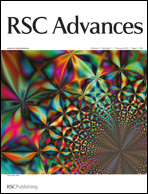Functionalized poly(vinyl alcohol) based nanofibers for the removal of arsenic from water†
Abstract
Arsenic is a potent contaminant in waterways across the world. In this investigation, Fe3+ ion immobilized poly(vinyl alcohol) (PVA) nanofibers were used for the removal of arsenic (As) from


 Please wait while we load your content...
Please wait while we load your content...